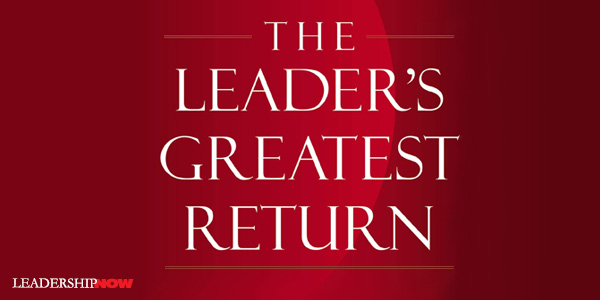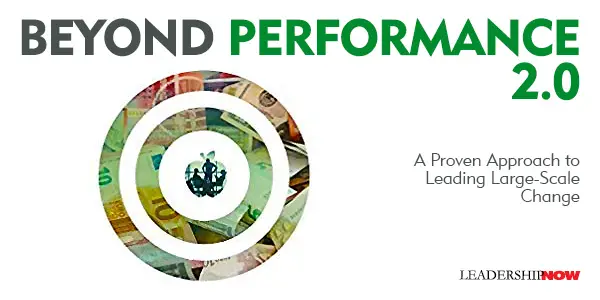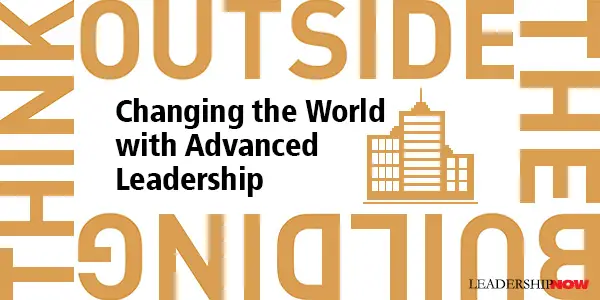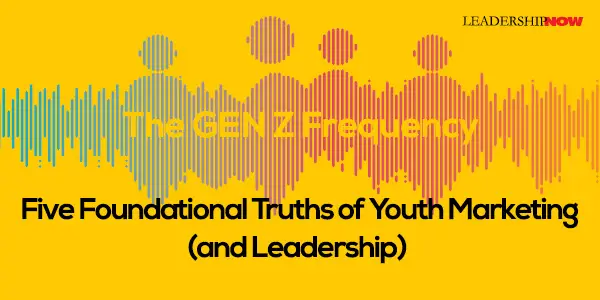 Leading Blog | Posts by Month |
 Leading Blog | Posts by Month |
02.29.20

LeadershipNow 140: February 2020 Compilation
See more on
Posted by Michael McKinney at 08:16 PM
02.27.20

Leading Thoughts for February 27, 2020
IDEAS shared have the power to expand perspectives, change thinking, and move lives. Here are two ideas for the curious mind to engage with: Microsoft CEO Satya Nadella shares his love of learning: “The one thing that I would say that defines me is I love to learn. I get excited about new things. I buy more books than I read or finish. I sign up for more online courses than I can actually finish. But the thing about being able to watch people do great things, learn new concepts, is something that truly excites me.” Source: Steve Clayton, Microsoft’s chief storyteller, interviews CEO Satya Nadella. YouTube (4:44) Jon Gordon on leading with optimism, positivity, and belief: “Ultimately, being a positive leader is all about leading with faith in a world filled with cynicism, negativity, and fear. We all face this battle between faith and fear. A leader’s job is to fill your people with faith. How we respond to our world depends on the stories we tell ourselves. When you face adversity you can tell a positive story and then work to create a positive outcome. It’s always your state of mind and your thinking that produces how you feel and respond. When you see that the world has no power over you, you will lead more powerfully in the world.” Source: The Power of Positive Leadership Look for these ideas every Thursday on the Leading Blog. Find more ideas on the LeadingThoughts index.
Posted by Michael McKinney at 02:43 PM
02.26.20

30 Hacks for Bringing Joy to Your Job
STRESS is a given in our lives. Not all of it is bad. For most of us it comes and goes, but for about 25% of us, it is a severe and constant reality according to one NPR/Harvard study. Many are experiencing anxiety leading to burnout at increasingly higher rates. There is something we can do to put joy back into our work. To that end, Bruce Daisley, a former VP at Twitter, offers 30 hacks for bringing joy to your job in Eat Sleep Work Repeat. Daisley draws on insights from a range of researcher and experts to identify three themes for creating happier work environments: Recharge Twelve simple hacks to restore energy, enthusiasm, and creativity. The fundamental problem is that we simply aren’t practicing behaviors that recharge us. And it shows. Several suggestions include: Try Going for a Walking Meeting. When we get our blood pumping through our bodies, there is evidence to suggest that walking rather than sitting will clear our heads and increase our creativity by up to 60%. Eliminate Hurry Sickness. Constant business doesn’t equal achieving more. Calibrate urgency. “On the next occasion, you find yourself asking for something urgently, ask yourself whether you really do need it ASAP. If you can make some things less urgent, you’re being more honest with yourself and helping to create a better working environment for everyone else.” Take time to reflect. Turn Off Your Notifications and Have a Digital Sabbath. Set up microboundaries to make technology work for you. Avoid weekend e-mails and work. Cal Newport says, “The modern work environment is actively hostile to Deep Work. I think the way that we’re approaching knowledge work we’re going to look back at in maybe fifteen years from now and say hat was disastrously unproductive.” We don’t know how to use the technology we have. Get a Good Night’s Sleep. Getting a good night’s sleep is “better than any other performance-enhancing intervention.” If you think you need to burn the midnight oil to get more done, consider that “you’re more likely to get where you need to be after eight hours sleep.” Sync Eight strategies that will bring trust and connection to your team, enhancing your powers of collaboration and building your collective intelligence. Several of the ways to improve team culture: Move the Coffee Machine. The secret to building Sync is to get people talking together. Help people come together by design. Create a Social Meeting. People experience Sync best in social situations. “Social time turns out to be deeply critical to team performance, often accounting for more than 50 percent of positive changes in communication patterns.” Laugh. “The looseness of thought that laughter provokes triggers our creative juices, encouraging free association of ideas.” A lack of laughter may signal that something is wrong on the team. Know when to Leave People Alone. Getting a team involved in a project too soon can be counterproductive. But we all need feedback and discussion to perform better. So there is a balance. “Sync is about people working together in harmony—but no amount of Sync will change the power of individuals applying gray matter to difficult problems alone. Creativity is about thinking and then discussion—a team in Sync will make sure it’s doing both.” Buzz Ten ways to get your team to a “buzz” state—a sense of engagement and positive energy. Positive Affect (our inclination to experience the world in a positive way) + Psychological Safety = Buzz. How can we bring Buzz into our workplace? Frame Work as a Problem You’re Solving. If we frame the challenge as a problem we all need to solve, we learn faster and together. “Frame the work as a learning problem, not as an execution problem,” and “introduce a clear sense of uncertainty into the room.” Focus on the Issue, Not the People. If you provide incentives to cooperate, employees will share information and train others, but if you pit people against one another, they will naturally think only of themselves. It comes as no surprise that “workplaces that put too much emphasis on individual performance find themselves achieving worse results.” Again, there is a balance. “Remove the personal element and encourage people to focus on the work at hand than the individuals involved.” Replace Presenting with Reading. While awkward at first, consider beginning each meeting by reading a document prepared for subsequent discussion. It can level the playing field. “Teams that have a more equal distribution of communication tend to have higher collective intelligence because you’re hearing from everybody, we’re getting information and input, and effort from everybody is they’re all contributing.” Successful teams are good at reading the nonverbal responses of others and adapting their behavior accordingly. Relax. “One reason why Buzz so often seems to be beyond our grasp is that we’re not good at being ourselves.” A good sense of humor goes a long way to create positive affect and psychological safety. “Researchers found that “those who laughed together were significantly more likely to share intimate details with one another, and to be closer to their real selves, than those in a nonlaughing control group.” While it’s true that for the vast majority of us, we can’t make these ideas company-wide policy, or control every demand placed upon us, we resort far too easily to blaming our circumstances on our company. We can do a lot for ourselves by approaching what we do differently. With a little personal responsibility and resourcefulness, most of these helpful hacks are within our grasp. Even a few of them would go a long way to improving our disposition. 
Posted by Michael McKinney at 11:21 PM
02.24.20

The Leader's Greatest Return
IF YOU want to make a difference in the world, go further, faster by developing other leaders. Your efforts are magnified exponentially by the investment you make in others. Of course, we talk about developing more leaders, but if we actually made it a priority, we would have more leaders. One issue leaders have always faced is the ability to identify potential leadership in the raw. It can be a bit counterintuitive. John Maxwell addresses these issues and more in The Leader’s Greatest Return. To help make this more practical and intentional, Maxwell has laid out a ten-step process for developing leaders. 1. Identifying Leaders: Find them so you can develop them. You need to know what you are looking for. What does a potential leader look like? Maxwell offers six As to guide us: Assessment of Needs (what do you need?), Assets on Hand (people within), Assets not on hand (people outside), Attitude, Ability, and Accomplishments. You’re looking for attitude before aptitude. Always begin with attitude. Good character is what holds together all the positive attitude traits I’ve mentioned—willingness to serve, selflessness, empathy, growth, and sacrifice. Character keeps everything secure. Without it, things can break down fast. Character is about managing your life well, so you can lead others well. 2. Attracting Leaders: Invite them to the leadership table. Leaders want to be around leaders. “Having a leadership table means creating a place in your organization or on your team where people have a place to learn, an opportunity to practice leadership with its successes and failures, and a chance to shine.” Leaders “see the future leader within the person, and help that leader emerge.” Inviting potential leaders to the table gives them a chance to practice leadership. As a learner there’s no substitute for participating and having access to people who know what they’re doing, can direct you, and give you feedback. That requires proximity. 3. Understanding Leaders: Connect with them before you lead them. Understand them. Learn their perspective. Before you lead and develop people, you need to connect with them. You need to find common ground with potential leaders, which is less about ability and more a function of attitude. They commit to you and follow when they feel understood. Maxwell lists ten actions to create that understanding: “Value them, let them know you need them, include them in your journey, adopt a teachable spirit, ask questions, listen well and often, seek to know their perspective, give credit to those who help you, express gratitude to those who help you, and replace me with we.” What Maxwell is talking about is humility. 4. Motivating Leaders: Encourage them to give their best. Don’t motivate. Inspire. I try to inspire people and help them find their own motivations. That means I must first find my own motivations and model the behavior I want to see in the people I lead. Good leaders inspire others only to the extent that they inspire themselves. 5. Equipping Leaders: Train them to be great at their job. Great leaders sponsor their potential leaders. “They position them and mentor them.” Sponsoring potential leaders is where you begin to see the return on your time and investment. Work yourself out of a job. Success doesn’t come from protecting what you have. It comes from equipping others to replace you so that you can move onto bigger and better things. When you become an equipping leader and teach potential leaders how to be great at their job, everybody rises. 6. Empowering Leaders: Release them to reach their potential. Give authority away. “Only secure leaders give power to others.” The main limitation most people have on their lives is their low expectations of themselves. Most people are unaware of the possibilities that lie within them. Good leaders introduce the people they lead to those wonderful possibilities. 7. Positioning Leaders: Team them up to multiply their impact. Bring your leaders together to develop a team of leaders. Maxwell explains the seven types of leaders to you want to invite to your leadership team. Teams of leaders are powerful. But they are difficult to create. Why? Leaders are hard to gather. And it can be a challenge to get them to work together. They all have their own ideas, and they would usually rather gather a team than be on one. 8. Mentoring Leaders: Coach them to the next level. Leaders have a responsibility to mentor others. For mentoring to work, it becomes a two-way street. As mentors, we should both teach and learn. The leader being mentored should move up to a higher level of leadership. The ultimate step in mentoring ends with the leader being mentored takin the baton from his mentor and surpassing him. 9. Reproducing Leaders: Show them how to develop leaders. “The only thing limiting the future of any organization is the number of good leaders it develops.” Maxwell says the kind of leaders you are trying to develop are what he calls 3-G leaders. “When I select leaders, I look for evidence of the three Gs. They have to be grounded, gifted, and growing. And as I develop them, I need to see them continue to develop in those areas to keep working with them.” Grounded as in possessing a foundation that makes them solid—humble, teachable, authentic, mature, and having integrity. Gifted in that they possess the strengths that can help them succeed in the service of others. And possessing a hunger and capacity to be developed—Growing. When you begin developing leaders, the most important thing you can do is let them know what you’re thinking and why. Bring them to the table and let them in on high-level meetings and discussions so that they can learn how you and other top leaders think. 10. Compounding Leaders: Receive the Highest return of developing leaders. Developing leaders benefits from what is called “accumulative advantage.” That is, a small initial advantage leads to a slightly bigger advantage that compounds over time to create a significant advantage. “That’s the return that comes from continually developing leaders. It compounds! And the longer you keep doing it, the greater your advantage becomes.” And you reap the compounding power of consistency. You can’t develop everyone. “Compounding results from developing the top 20 percent. If I have ten people on my team, I incest 80 percent of my time and effort into my top two—my top 20 percent. I add value to them, so they can multiply value to others.” Those two can then develop the top 20 percent of those they influence and so on. Developing leaders pays dividends to you, those you develop, and to everyone they influence. Developed leaders help you carry the load, leverage your resources, help you create momentum, expand your influence, ensure a future, develop others, and develop you. It’s dangerous to think you’ve arrived as a leader. As someone once quipped, today’s peacocks are tomorrow’s feather dusters. If you want to keep leading, you need to keep growing, and few things stretch a leader like leading growing leaders. The Leader’s Greatest Return is one of the most important books Maxwell has written. It brings together, in a meaningful whole, the culmination of over 50 years of experience leading and learning to lead. It provides a holistic view of leadership and applies the laws he has written about previously in The 21 Irrefutable Laws of Leadership and other classic leadership books to the most meaningful function of leadership—developing more leaders. 
Posted by Michael McKinney at 11:30 PM
02.21.20

All You Have to Do Is Ask
IF WE ARE HONEST with ourselves, we know there are times we need help. We just don’t want to ask for it. We’re confident we can figure it out. In time. But here’s the thing. There’s nothing we are going through or trying to figure out that others haven’t blazed a trail for us already. We just need to ask. Wayne Baker says, “you never know what people know—or who they know—until you ask. Asking for help can mean the difference between success and failure.” In All You Have to Do Is Ask he identifies eight reasons why we don’t or won’t ask. As a result, we leave a lot of answers, solutions and resources on the table for no good reason. And here are eight no good reasons:
That last reason—the fear of seeming selfish—relates to the proverb that it’s better to give than receive. That’s true. We want to be givers, but that doesn’t make receiving a bad thing. “There’s no giving without receiving, and there is no receiving without giving. And it’s the request that starts the wheel turning.” Baker offers a quick scientific assessment in the book (or online) to determine what style of asking/giving you tend to choose. And it is a choice. Are you an overgenerous giver, a selfish taker, a lone wolf, or a giver-requester? These types all represent “choices you can make about how you want to operate in the world.”
The place to begin is to understand and articulate your needs. Know what you are trying to accomplish and when. With that in mind, formulate a SMART request. That is a Specific (“a specific request yields more help than a vague one”), Meaningful (“Why is the request important to you?”), Action-oriented (What action do you want to be taken?), Realistic (it may be a serious long-shot, but within the realm of possibility), and Time-bound (“every request should have a due date”) request. After you have formulated your request, you need to figure out who to ask. Who knows what you need to know or who you need to talk to? Go outside your usual circle of contacts. Then ASK. And a good piece of advice: “Rejection is just an opinion. And opinions change. In other words, you can find ways to turn a no into a yes.” Baker offers much more specific advice and examples throughout but let me mention two tools that have proven effective that Wayne Baker and Adam Grant have developed. The first is Reciprocity Rings. Reciprocity Rings A Reciprocity Ring is a group activity consisting of 20 or so people that gather together and share a request with the group one by one. “Other members of the group pause to consider how they could help: Do I have the resource the person needs? Of not, do I know someone in my network who might be able to help? Because it’s much easier for people to make a request when they know that everyone must make one, every participant is required to make a request; asking is the ‘ticket of admission’ to the Reciprocity Ring.” Reciprocity Rings have been implemented successfully at Google, General Motors, IBM, Citigroup, UPS, and others. Givitas Givitas is a collaborative technology platform that provides a safe platform for requesting, giving, and receiving help across boundaries across a vast scale. It helps you share widely beyond the usual suspects. Platforms like Givitas allow people to get what they need without having to repeatedly tap all the same experts or all the usual go-to people because requests are decentralized and broadcast across the vast network. Thanks For Asking We’ve all asked for help only to be rebuffed or made to look stupid. Of course, we recognize and reward people for giving help, but we don’t typically reward people for asking for help. “How our request is received, how we are treated, and how the help is granted determines whether we get discouraged, or encouraged to make asking a personal practice.” With both organizational and individual success at stake, we need to rethink our responses to asking. “Recognizing, appreciating, and rewarding those who ask is as critical as doing the same for those who answer.” Baker shares informal and formal ways we can as individuals and organizations recognize, reward, and encourage asking. Asking improves individual performance and effectiveness. All You Have to Do Is Ask will change your appreciation of asking. It certainly changed my view. 
Posted by Michael McKinney at 05:34 PM
02.20.20

Leading Thoughts for February 20, 2020
IDEAS shared have the power to expand perspectives, change thinking, and move lives. Here are two ideas for the curious mind to engage with: I. Porter Moser, head coach of the Loyola University Chicago men’s basketball team, on how to find success: “How you think is how you feel, how you feel is how you act, and how you act is what defines you. I believe completely in the progression of these three statements. If you’re thinking good thoughts, you’re going to have a bounce in your step. You’re going to act in a certain way. Likewise, if you’re thinking negative thoughts, if you have a ‘poor me’ attitude, that’s how people will perceive you.” Source: All In: Driven by Passion, Energy, and Purpose II. Jeffrey Hull on being a beta leader: “Beta is a shift in mind-set from a goal-oriented, top-down figuration to a growth-oriented, process-based one. When we live in beta, we are in flux, always improving, and always aware of the need to disrupt the status quo. Beta means being comfortable in a state of constant growth, not aspiring so much to ascend the hierarchy and dominate from above, but to lead from anywhere, anytime.” Source: Flex: The Art and Science of Leadership in a Changing World Look for these ideas every Thursday on the Leading Blog. Find more ideas on the LeadingThoughts index.
Posted by Michael McKinney at 07:48 AM
02.19.20

Organizational Health and Performance: Beyond Performance 2.0
PERHAPS it goes without saying, but a healthy organization will achieve more than an organization that is too sick to support your goals. So, any change effort will be more successful when you focus on both performance and health. Considering that most change efforts only succeed 30% of the time, Scott Keller and Bill Schaninger (both McKinsey partners) put forth a change model to increase the odds of success (upwards of 79% of the time) in Beyond Performance 2.0. Successful change efforts are increased when we place equal emphasis on both performance and health-related efforts. The authors define performance as “what an enterprise does to deliver improved results for its stakeholders in financial and operational terms. Health is about the how. “Health is how effectively an organization works together in pursuit of a common goal. A more memorable way to think about health-related actions is that they are those that improve how an organization internally aligns itself, executes with excellence, and renews itself to sustainably achieve performance aspirations in its ever-changing external environment.”
An overemphasis on performance often causes a negative impact on organizational health leading to catastrophic failures in performance. We need t look no further than Volkswagen’s “dieselgate” scandal in 2015. Poor organizational health lead to cutting corners and rule-breaking. Samsung’s 2016 Galaxy Note 7 smartphone recall was attributed to its “deeply entrenched culture of urgency.” An equal focus on health would have mitigated these issues. An emphasis on both performance and health can be mace part of the change process by applying what they call the Five Frames of Performance and Health. The framework revolves around five questions:
Each of these questions is addressed in the framework for performance and health. These are the five frameworks for performance:
Here are the five frameworks for health:
What makes this all work is being intentional about both issues at the same time. They work with each other to bring you lasting change. The better the health of the organization the better your performance, and as your performance improves, it boosts your organizational health. The relationship is dynamic and not linear. As you move forward, plans change, conditions change, and assumptions are challenged. When this happens, you simply go back to, for example, the Assess question, “How ready are we to go there?” and make adjustments as necessary. An added benefit of this framework is that as you reach your goals, the organization learns and applies those learnings increasing the organization’s capacity for renewal. It moves you out of static thinking and into a learning mindset. And while our environment is continually changing, we have control over organizational health and therefore, can reap the increased adaptability it brings in spite of our circumstances. Gary Hamel put it well in his forward to our first addition, “Beyond Performance is far more than a guide to leading a successful change program. It’s a manifesto for a new way of thinking about [how] organizations … become, fundamentally, pro-change.” It’s not just about getting ahead; it’s about staying ahead. 
Posted by Michael McKinney at 08:15 AM
02.17.20

How to Get Venture Capital: Secrets of Sand Hill Road
VENTURE CAPITAL is not right for every business. But if you determine that it is right for you, you should read Secrets of Sand Hill Road by Scott Kupor, the managing partner at Andreessen Horowitz. It is a book for those with big ideas. Beginning in the 2000s, capital became more abundant due in large part to the costs required to start a new company. Consequently, the amount of money a start-up needs to raise has declined significantly. Beyond that, there are more angel investors to provide early-stage funding. And the size of the funds has increased as institutions have contributed to VC funds allowing them to fund growth throughout a startup’s life cycle. VC firms stay with their investments longer (upwards of ten years), often providing advice, support, a network of relationships, and coaching to improve the odds of success. Of course, most investments don’t work out. 50 percent don’t. 20 to 30 percent of businesses invested in make a return over the investment. 10 to 20 percent are home runs where an investment returns ten to one hundred times the investment. It’s those home runs that make the whole thing work. Understanding those economics will help you to align your objectives with the sources of the funds you need. VCs don’t always get it right because, at the beginning, there are really no hard numbers to go on. To determine if funding your venture is right for them, they look for three things: 1. People and Team If the idea is a good one, we have to assume that there are others thinking about doing the same thing. “So what matters most is, why do I as a VC want to back this particular team versus any number of the x-number of other teams that might show up to execute this idea? A decision to invest means that the VC cannot invest in a different team that may come along and ultimately be better equipped to pursue the opportunity.” VCs are trying to determine whether this founder will be able to create a compelling story around the company mission in order to attract great engineers, executives, sales and marketing people, etc. 2. Product Because the original idea is not likely the idea or product that will ultimately go to market, the VC wants to know how the founder came up with the idea. They want to know the process. They like founders that “have strong opinions but ones that are weakly held, that is, the ability to incorporate compelling market data and allow it to evolve your product thinking.” In other words, “they want to be comfortable that your process of evaluating the market needs to date is robust enough to enable you to adapt appropriately to changing market demands.” The idea or product also must be significantly different to move people. Great illustration of this point: Ben Horowitz uses the difference between a vitamin and an aspirin to articulate this point. Vitamins are nice to have; they offer some potential health benefits, but you probably don’t interrupt your commute when you are halfway to the office to return home for the vitamin you neglected to take before you left the house. It also takes a very, very long time to know if your vitamins are even working for you. If you have a headache, though, you’ll do just about anything to get an aspirin! They solve your problem and they are fast acting. Similarly, products that often have massive advantages over the status quo are aspirins. VC want to fund aspirins. 3. Market Size What matters most is the size of the market you’re going after because the bigger the market the better the odds of a home run. Kupor delves into how VCs are funded and why it matters to the entrepreneur. Specifically, ask how old the fund is from which you are receiving payment. If it is generally towards the end of its life cycle, there is will be additional pressure on you to return capital or exit. Also, at the beginning of the life cycle there are generally funds reserved for additional rounds of funding. Importantly, he covers what form your company should take (C Corp), stock vesting, up-front agreements, intellectual property, and employee option pools. How much money should you raise? This is something founders often get wrong. The simple answer is: “to raise as much money as you can that enables you to safely achieve the key milestones you will need for the next fund-raising.” Raise the first round with the second round in mind. Thus, if you are raising your first round of financing (typically called the Series A round), you will want to raise an amount of money that gives you enough runway to get to the milestones you will need to hit to be able to successfully raise he next round of financing (the Series B) at (hopefully) a higher valuation than the A round. In the discussion of the art of the pitch, Kupor notes that VCs aren’t expecting you to be clairvoyant, but “you do need to demonstrate to the VCs that you are the master of the domain you are proposing to attack and that you have thought about every important detail of your business in a way that shows depth of preparation and conviction.” Kupor also covers the less exiting—but critical—legal and financial aspects of funding like term sheets, valuation, voting rights, the board, stock, insurance, vesting, and founder issues. Actually, he covers it in the most straight-forward manner I’ve ever read. Secrets of Sand Hill Road is a must-read for anyone considering entrepreneurship. Kupor takes the mystery out of funding and clearly explains why things work the way they do. You will discover the inner workings of the VC-Founder partnership. If you are an entrepreneur, this book will help you get to know your partner. 
Posted by Michael McKinney at 08:13 AM
02.14.20

Think Outside the Building
SYSTEMIC SOCIAL ISSUES cannot be solved by a few people working in isolation. They can be better addressed by breaking out of traditional approaches and collaborating with others. Rosabeth Moss Kanter likens these traditional approaches to castles. In Think Outside the Building, she writes, “Castles are any set of institutional structures that loom large and feel permanent. Castles are monuments to the past and to past thinking, museums of preservation.” Moving outside of these castles is the beginning of innovation. For example, “health is equated with hospitals, education with schoolhouses, news with newspapers, spirituality with the church, a city with city hall.” And we look to these institutions for solutions. But the solutions lie outside the “castle.” Health isn’t the hospital or even the doctor’s office. Health might be a function of nutritious food, clean air, or stress-free work. But behemoth establishments dominate health care, including rival fiefdoms such as providers and insurance companies, full of fortification and defenses, sometimes shutting out alternatives for treatment or blocking routes to wellness. The same can be said of educational systems, city governments, and other institutions that we look to for answers. Kanter says the best way to deal with these entrenched systems is not to attack them head-on, but to go around or under, or even start something new that is so attractive that others flock to it. Advanced Leadership To encourage this kind of action, professors Kanter, Rakesh Khurana, and Nitin Nohria co-founded the Harvard Advanced Leadership Initiative as a third level of education to bring together experienced leaders who could then go and address some of the world's most challenging problems. But the Advanced Leadership is not specifically about older, more experienced people, but a level of thinking that takes leaders of any age, out of the building, “beyond boundaries, across silos, and outside established structures.” Advanced Leadership is a different mindset than single-minded leadership furthering its own goals within a single organization. “Complex, messy, ambiguous, contentious institutional problems require more of leaders than exercising the authority inherent in their roles; they take entrepreneurial hustle. That also requires a larger pool of leaders willing and able to tackle them.” We need more Advanced Leaders. Kaleidoscope Thinking A different kind of thinking—kaleidoscope thinking—is required. “Creativity is a lot like looking at the world through a kaleidoscope. Innovators shake up their thinking as though their brains are a kaleidoscope, permitting an array of different patterns out of the same bits of reality. Leaders who take on big, intractable systems problems must be able to break out of prevailing wisdom in order to move beyond it. The fragments of your kaleidoscope as built over time. Experiences, frustrations, and observations waiting to be connected when the time is right. Digital innovator John Taysom said, “Dream your worst nightmare, then invest in it,” or “see the thing that upsets you and use it as an opportunity for change.” Get out and experience the new and truly different to shake the kaleidoscope into new possibilities. “What differentiates advanced leaders from noninnovators is that they can see further because of their quality of preparation and attention. They zoom out to see the big picture; they tune in to the context and read the zeitgeist.” Advanced leaders are always looking. Look for what’s not there. Look for the gaps. Advanced leaders must learn to tell a different story in order to gain support. “If you don’t like how things are going and want to lead change, tell a different story.” Reframe the problem to illuminate possibilities. Stories can’t be fairy tales. Narratives should be evidence-based, meeting a plausibility test. Marshalling the evidence sometimes requires creating new evidence through pilot programs—something that people can see and touch, something that has “street cred” (visible on the street. Prototypes are fundamental. Kanter explains the need, the process, and the trials of advanced leadership in the face of “castles” through example after example of those who are outside the building trying to make a difference. It is an instructive and inspiring book. It is a call to action into the unknown with a distinguished guide. The nature of change challenges, whether inside corporate offices or beyond the walls, increasingly requires more than traditional hierarchical leadership skills guiding teams inside the building; the new challenges require advanced leadership. For institutions that are threatened with disruption and displacement, this kind of leadership is essential because they simply can’t keep singing variations of the same old refrains with a digital note added here or there. And as the routinized parts of jobs are replaced (or augmented) by technology, increasing numbers of people will find themselves working on tasks outside the building. 
Posted by Michael McKinney at 06:48 AM
02.13.20

Leading Thoughts for February 13, 2020
IDEAS shared have the power to expand perspectives, change thinking, and move lives. Here are two ideas for the curious mind to engage with: I. Rachel Botsman discussing trust issues that revolve not just around trust and technology, but trust issues around size: “I think so much of what we need in our lives are smaller systems, where you can really serve people’s best interests. I am a huge supporter of local news, I’m a huge supporter of community practices, all these things are very important touchpoints where people can say “that thing is really there for me” versus “this massive system in the world that I have no control of” which I think is really tied to the huge rise in anxiety that we’re seeing in the world today.” Source: 6 Things 2020 Holds for Us According to An Expert II. Economist and professor John Kenneth Galbraith on how seemingly hopeless situations invite scoundrels who promise by magic to put everything right: “Men who are desperate for a solution are easy to persuade because they wish desperately to be persuaded.” Source: The Age of Uncertainty Look for these ideas every Thursday on the Leading Blog. Find more ideas on the LeadingThoughts index.
Posted by Michael McKinney at 07:10 AM
02.12.20

Why You Should Sponsor Others
MUCH HAS been written about mentoring. Mentoring is a gift you give to others. And while mentoring can be of tremendous value to the person being guided, it is one-way. Sponsoring is “all-in.” You have skin in the game. Sponsorship is a two-way, reciprocal investment where both the sponsor and the protégé are working for each other’s success. It goes without saying that having a sponsor is a huge career plus, but here’s the startling fact, being a sponsor is just as important as finding one. Sylvia Ann Hewlett reports in her book, The Sponsor Effect, “Senior-level managers are 53 percent more likely to have received a promotion in the last two years, if they have a protégé.” In addition, “Entry-level professionals who have a protégé are 167 percent more likely to have received a stretch assignment than those who don’t.” And for those who were actually doing sponsorship right, the results were even better. The point is, become a sponsor. It’s good for you too! The sponsor must devote serious attention to identifying top junior talent, developing their skills, scrutinizing their progress, and advocating on their behalf (or more practically stated, believing in them and using up precious political capital for them, advocating for them, and providing them with air cover to take the risks that success often demands). Protégés must deliver for their sponsor with stellar performance, rock-solid trustworthiness, and a differentiated skillset that adds value to the team and the organization, as well as to the individual sponsor. Take note: “The right protégé will complement your leadership skills and style, provide honest feedback, make you feel that you have extra hours in the day, and enable your influence to persist even after you’ve moved on to your next role or opportunity.” Seven Steps to Effective Sponsorship Hewlett offers a playbook to do this right. Taking a chapter for each, she explains how to get started, and answers questions like how do you contain risk? And What tools and tactics work best. After all, “If you’re going to sponsor someone—linking their career to yours—they’re going to be walking around with your brand on their forehead.” Step 1: Identify Potential Protégés Step 2: Include Diverse Perspectives Step 3: Inspire for Performance and Loyalty Step 4: Instruct to Fill skills Gaps Step 5: Inspect your Prospects Step 6: Instigate a Deal Step 7: Invest in Three Ways The following example Hewlett shares highlights the value of sponsorship to help leadership groups break out of their shared biases and points of view that so often hold them back. “In this business today, if you want to grow, you’ve got to be comfortable with being uncomfortable,” Lou Aversano, CEO of Ogilvy & Mather in New York (a division of WPP), told me. “You have to be willing to burn your lifeboats before someone burns them for you.” Yet industry veterans such as himself face a challenge that he calls “altitude.” Sponsorship requires an investment of time, but it has immediate value. You can begin to see the benefits very quickly. So, find some protégés today. The Sponsor Effect offers a formula to get it right. 
Posted by Michael McKinney at 08:23 AM
02.10.20

Peak Leadership Fitness: Elevating Your Leadership Game
ELEVATING your leadership game is a mindset. Your mindset drives your behavior and your influence on those you lead. You are in control of your mindset. In Peak Leadership Fitness, author Timothy Tobin writes, “A leadership mindset is essentially the belief in yourself and your abilities as a leader. A negative leadership mindset is rooted in self-doubt, uncertainty, and lack of inquiry. A positive one, on the other hand, based on a realistic view of yourself, your potential, and how you view [the] potential of others.” This mindset can be developed with effort and curiosity. Tobin has found that these four principles will help you on that journey: Principle 1: You never know what you’re capable of until you take that first step. “Leadership is an extreme test of performance, stamina, and endurance. It requires sacrifice and training. It requires setting ambitious (stretch) goals for yourself. Progress—even when falling short of your goal—is a great way to calibrate your capabilities for your next effort.” Principle 2: You must put in the effort. Nothing happens by chance. “When you put in the effort, your current strengths and expertise become a platform or you to build upon. As you build, you raise the bar for your capabilities, establishing a new standard for your performance.” Principle 3: You learn more about yourself when times are tough. (In other words: Never give up.) “Adversity tends to be unpredictable, so you may not know when it will strike or what form it will take. The difference in whether you react or respond comes down to your preparation.” Principle 4: What you consume matters. “Leaders won’t perform at their best if they do not focus on their development to development activities that advance their skills.” Where to Begin? Any leadership development journey begins with a baseline established through self-awareness. Tobin believes that a 360-degree assessment—a process through which feedback is solicited from peers, subordinates, superiors, and yourself—is the best place to begin. If enough people are included in the assessment, it can give you a good idea of those areas you need to begin focusing on and track your progress. Self-awareness is crucial to leadership success. Begin by developing your leadership core, which encompasses four general areas: Technical Skills: Knowledge about your domain, your business (including financial), and your industry.

Posted by Michael McKinney at 08:03 AM
02.07.20

The Trumpet and the French Horn: Two Styles of Communication
EFFECTIVE COMMUNICATION requires that we know how to best communicate with others. In other words, communicate with them the way they want to be communicated to. Diana Peterson-More shares two ways people like to take in information in her very practical book Consequential Communication in Turbulent Times, direct and indirect. Communication can be direct and straightforward, which often entails using the “w” words: “What do you think? What would you like me to do? What’s your answer? Why should we do it that way? Why her not me? Why not do it this way?” or “Which direction should we take?” To illustrate this concept, she introduces trumpets and French horns: For those who like the straightforward style of communication, let’s call them trumpets. The thoughts go straight from the brain to the mouth in an immediate exhale/response. “W” questions typically work with trumpets. 
Posted by Michael McKinney at 10:27 AM
02.06.20

Leading Thoughts for February 6, 2020
IDEAS shared have the power to expand perspectives, change thinking, and move lives. Here are two ideas for the curious mind to engage with: I. Samuel R. Chand, a leadership author and consultant, on disruption: “A fighter pilot knows he's in the right spot when he's getting anti-aircraft fire. If you're not catching flack for your disruptive idea, you're not over your target yet. Keep flying.” Source: New Thinking, New Future II. Michelle King in stressing that gender equality is not about fixing women, but fixing workplaces, says: “Gender equality is not about raising women up at the expense of men. It is not about making men feel bad or listing all the ways than men need to change. Quite the contrary. It is about creating a workplace that values men and women equally and gives everyone the freedom to be themselves.” Source: The Fix: Overcome the Invisible Barriers That Are Holding Women Back at Work Look for these ideas every Thursday on the Leading Blog. Find more ideas on the LeadingThoughts index.
Posted by Michael McKinney at 07:19 AM
02.05.20

Five Foundational Truths of Youth Marketing (and Leadership)
WHO IS Gen Z? They are people born between 1996 and 2011. What is their frequency? Their generational voice is diverse, engaged, knowledgeable, pragmatic, collaborative. And while they share common values, they are very independent. In The Gen Z Frequency, authors Gregg Witt and Derek Baird tackle this demographic which is projected to be the largest consumer demographic in history. The HRC Retail Advisory forecasts this generation to drive 40% of all US consumer spending, and yet it is one of the most challenging generational cohorts for brands to reach. It is an important and comprehensive book for marketers, but there are some principles they share that have a much wider application, that I wanted to share. In the book, they list the five foundational truths of youth marketing (and leadership). Each truth is introduced by a well-chosen quote that is worth applying more broadly in a leadership context. They are: Truth 1: Identity Gone are the days when brand identity is built with a bullhorn. We all know that brand identity is now the sum of every consumer experience, but that doesn’t mean covering the spread of fragmented media with one brush stroke. In our opinion, context is just as important as content. It’s about brands boldly proclaiming a belief in why they exist in the first place, then proving it in ways that shape-shift within the medium and the context of media. In other words, prove that you are who you say you are in as many ways as you can. –Adam Wilson, 2018, Former director of brand marketing for Carhartt, North America Truth 2: Trust Trust? It’s everything. When it’s there, when it’s really there, that’s how a brand gets brought to life, protected and defended, grown and shared in the most authentic and powerful way possible. Trust takes belief, belief takes faith, and faith takes nurture and care. It takes more than a product, a promise, or a campaign. We work to earn trust in everything we say, everything we make and everything we do. Period. This is an important lesson I learned early on and continue to bring with me wherever I go. –Nicholas Tran, 2017, marketing executive and thought leader at global consumer electronics brand Truth 3: Relevance Staying relevant with Gen Z requires brands to stay on the pulse of everything happening in culture. And not just a gut check a few times a year…it requires a daily pulse of what this audience is talking about, feeling, and connecting with emotionally. From politics to pop culture, Gen Z admires brands who are willing to engage in timely conversations. –Michael Abata, 2018, cultural and consumer futurist Truth 4: Possibility Find a creator – a real creator, not a fake one – one that speaks to and inspires the audience you’re after. Partner with them for six months, a year or longer with a goal of becoming a true member of that creator’s community. Don’t tell them what to say – instead enable them – and through them, their community – to go places, do things, discover possibilities. Become part of that creator’s community, but let the creator chart the course, set the sails and choose the destination. You’re not buying media; you’re not running a campaign. You’re joining a community. Be respectful, but generous, but mostly keep your mouth shut. With the right match between creator, community and brands, the results will be amazing. –Jim Louderback, 2018, CEO Vidcon Truth 5: Experience A fundamental part… perhaps the fundamental part of humanity is to derive meaning from our existence, in the broader context of the universe. Gen Z is coming of age in a time period where we are constantly given digital reminders that we are not alone. An individual experience, recorded on a Snapchat or Instagram story, is almost immediately integrated into a broader ‘story’ pooled together by hashtag or geographic location. Technology has given us the tools to show us, in real-time, that we are one piece of a much larger puzzle. Brands need to become part of this larger puzzle and contribute to the overall experiences of this generation. –Sara Unger, 2018, Senior Vice President, Cultural Insights and Strategy, Civic Entertainment Group 
Posted by Michael McKinney at 08:52 AM
02.03.20

The Answer is Yes! Now, What Was Your Question?
YOU SHOULD shoot for the moon when it comes to customer service says customer experience guru Micah Solomon. When you are small it is easy to give that personalized service to each customer. But when the orders begin to pour in, the attentiveness begins to slacken. In Ignore Your Customers (And They’ll Go Away), Solomon says that “there’s no such thing as ‘customers’ in the plural. Rather, there’s just one customer: the one who’s being served right now.” He begins with a concept he calls “automatic positivity.” It is an approach that says “yes to customer requests, rather than defaulting to an easy ‘no’ or one of the many synonyms for no.” The point is to find a way to accommodate your customers. In the event that you have to say no, “there’s almost always a way to soften the blow. The solution, generally, is to restrain yourself from delivering this final no without having a yes to offer in the same breath. Offer an alternative solution and an apology that is likely to make your ‘no’ easier to accept.” There are obvious exceptions to this approach when there are health, safety, or security issues involved. How to Build Automatic Positivity 1. Model “yes behavior” yourself. If you hear yourself frequently telling customers some version of, “I’m afraid we cannot accommodate that request,” your employees will follow suit and find opportunities to like wise refuse to accommodate customers. 2. Spell out your commitment to yes. Write the default o yes (including the nuances of what to do when you can’t say yes) into your company standards—and publicize those standards throughout the company. 3. Preach the gospel of defaulting to yes, starting in the very first minutes of employment. Make it clear, from the first days of an employee’s tenure, that the way things are done around here is with customer-focused flexibility; that working here involves an ongoing attempt to maintain, in almost all situations, a default of yes. 4. Support your employees in getting to yes. From their first fledgling, awkward attempts to find a yes for customers to their later, more-refined performances, employee efforts at yes deserve encouragement and applause. Solomon goes behind the scenes of some of the great customer service organizations like Nordstrom, Zappos, The Ritz-Carlton, and many others. The end of each chapter has a Reader’s Cheat Sheet/Summary as well as a Reading Group Guide to help make the insights actionable. 
Posted by Michael McKinney at 11:17 AM
02.01.20

First Look: Leadership Books for February 2020Here's a look at some of the best leadership books to be released in February 2020. Don't miss out on other great new and future releases.
Life is not what you get out of it . . . it's what you put back in. Yet our current means for summarizing life's work, from resumes to salaries, are devoid of what matters most. This is why the work we do is often bad for our wellbeing, when it should be making us happier and healthier. What are the most meaningful contributions we can make? This is Life's Great Question. Life is about what you do that improves the world around you. It is about investing in the development of other people. And it is about efforts that will continue to grow when you are gone. Life's Great Question will show you how to make your work and life more meaningful, and greatly boost your wellbeing. In this remarkably quick read, author Tom Rath describes how finding your greatest contribution is far more effective than following talent or passion alone.
As the most trusted mental coach in the world of sports, Trevor Moawad has worked with many of the most dominant athletes and the savviest coaches. From Nick Saban and Kirby Smart to Russell Wilson, they all look to Moawad for help finding or keeping or regaining their competitive edge. (As do countless business leaders and members of special forces.) Moawad's motivational approach is elegant but refreshingly simple: He replaces hardwired negativity, the kind of defeatist mindset that's nearly everybody's default, with what he calls "neutral thinking." His own special innovation, it's a nonjudgmental, nonreactive way of coolly assessing problems and analyzing crises, a mode of attack that offers luminous clarity and supreme calm in the critical moments before taking decisive action. Not only can neutral thinking raise your performance level-it can transform your overall life.
When it comes to improving customer experiences, trying out new business models, or developing new products, even the most experienced managers often get it wrong. They discover that intuition, experience, and big data alone don't work. What does? Running disciplined business experiments. And what if companies roll out new products or introduce new customer experiences without running these experiments? They fly blind. That's what Harvard Business School professor Stefan Thomke shows in this rigorously researched and eye-opening book. It guides you through best practices in business experimentation, illustrates how these practices work at leading companies, and answers some fundamental questions: What makes a good experiment? How do you test in online and brick-and-mortar businesses? In B2B and B2C? How do you build an experimentation culture?
Most businesses identify six key digital technologies―artificial intelligence (AI), distributed ledgers and blockchain, the Internet of Things (IoT), autonomous machines, virtual and augmented reality, and 5G communication―as critical to their relevance and growth over the coming ten years. These new disruptive technologies present significant opportunity for businesses in every industry. The first businesses to understand automation and these transformative technologies will be the ones to reap the greatest rewards in the marketplace. The Innovation Ultimatum helps leaders understand the key technologies poised to reshape business in the next decade and prepare their organizations for technology-enabled change. Using straightforward, jargon-free language, this important resource provides a set of strategic questions every leader will need to ask and answer in order to prepare for the impending changes to the business landscape.
When it comes to setting and meeting goals, we may see—quite literally—our plans, our progress, and our potential in the wrong ways. We perceive ourselves as being closer to or further from the end than we may actually be depending on our frame of reference. We handicap ourselves by looking too often at the big picture and at other times too long at the fine detail. But as award-winning social psychologist Emily Balcetis explains, there is great power in these misperceptions. We can learn to leverage perceptual illusions if we know when and how to use them to our advantage. A mind-blowing and original tour of perception, Clearer, Closer, Better will help you see the possibilities in what you can’t see now. Inspiring, motivating, and always entertaining, it demonstrates that if we take advantage of our visual experiences, they can lead us to live happier, healthier, and more productive lives every day.
New York Times best-selling author Patrick Lencioni has written a dozen books that focus on how leaders can build teams and lead organizations. In The Motive, he shifts his attention toward helping them understand the importance of why they’re leading in the first place. In what may be his edgiest page-turner to date, Lencioni thrusts his readers into a day-long conversation between rival CEOs. Shay Davis is the CEO of Golden Gate Alarm, who, after just a year in his role, is beginning to worry about his job and is desperate to figure out how to turn things around. With nowhere else to turn, Shay receives some hard-to-swallow advice from the most unlikely and unwanted source―Liam Alcott, CEO of a more successful security company and his most hated opponent. Lencioni uses unexpected plot twists and crisp dialogue to take us on a journey that culminates in a resolution that is as unexpected as it is enlightening.
 Build your leadership library with these specials on over 39 titles. All titles are at least 40% off the list price and are available only in limited quantities. “The man who does not read good books is no better than the man who can’t.” — Mark Twain
Posted by Michael McKinney at 05:42 PM
|
BUILD YOUR KNOWLEDGE


How to Do Your Start-Up Right STRAIGHT TALK FOR START-UPS 
Grow Your Leadership Skills NEW AND UPCOMING LEADERSHIP BOOKS 
Leadership Minute BITE-SIZE CONCEPTS YOU CAN CHEW ON 
Classic Leadership Books BOOKS TO READ BEFORE YOU LEAD |
|